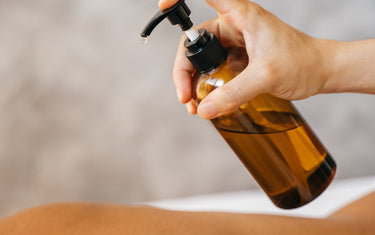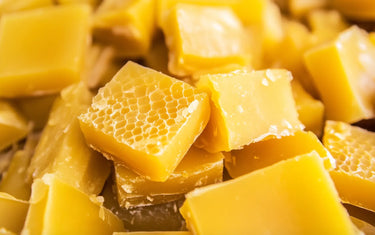12 min read / 1 February 2024 / yasmin sharp
What is a Carrier Oil?
Learn about the use of jojoba, argan, coconut and others in diluting essential oils, enhancing skincare routines, and promoting wellbeing.
Share this post

What are the benefits of using carrier oils?
What are the best carrier oils for skin?
What are the best carrier oils for hair?
What are the best carrier oils for nails?
How do you choose the right carrier oil?
How is each carrier oil different from each other?
How to blend carrier oils with essential oils
Whilst a lot is known about essential oils, one of the most common questions we are asked by customers is: “What is a carrier oil?”
As we explain in more detail below, carrier oils can not only provide a variety of health benefits when used independently, but they also provide critical support for the application of essential oils.
To explain more, and to help you on your journey towards improving your skincare routine, here we explain everything related to carrier oils, including their benefits, how to use them and much more.
What is a carrier oil?Carrier oils are oils that have been extracted from plants and are typically used to dilute essential oils, helping to safely ‘carry’ them onto the skin. They are also scientifically referred to as ‘fixed oils’ because unlike essential oils, they are more stable and do not evaporate with heat. Common examples of carrier oils include jojoba, sweet almond, argan and fractionated coconut oil. Carrier oils are usually unscented or lightly scented, which ensures they do not interfere with the therapeutic properties provided by the essential oils they are mixed with. Whilst most people can apply carrier oils directly to your skin without any issue, you should not use undiluted essential oils as they are extremely potent and can cause irritation and allergic reactions for some. |
What are the benefits of using carrier oils?
When asking “What is a carrier oil?” It's also helpful to understand the benefits they can offer.
We’ve put together a short list of how some of the most popular carrier oils can help your wellbeing.
1. Coconut oil could help you to lose weight
Fractionated coconut oils ability to offer a mixture of antimicrobial properties, essential fatty acids and polyphenols make it ideal for use on skin, with many people believing it can help to ease inflammation.
It is also used to improve the appearance of some skin conditions – although because it is highly comedogenic it can clog pores and encourage acne in some users.
Research also suggests that it could be used to aid weight loss due to the strong presence of medium-chain triglycerides (MCTs).
Studies that replaced other fats in the diet with MCTs found that they help to burn more calories and fat, lower calorie intake and are less likely to be stored as fat. [1] [2] [3]
2. Jojoba oil moisturises and soothes the skin
Jojoba oil is sourced from the seeds of the jojoba plant, producing a golden-yellow colour that is either lightly scented or odourless.
Because it is a humectant ingredient (meaning it can draw water on skin, hair and nails) jojoba is highly regarded for its moisturising properties because it doesn’t clog pores upon application.
The oil’s antifungal and antimicrobial properties have been found to kill certain strains of fungi and bacteria that are responsible for causing salmonella, candida and an E. coli infection. [4]
In addition, jojoba oil works as an antioxidant because it contains natural forms of vitamin E, which is a proven antioxidant. [5]
This also makes it useful for managing acne symptoms, reducing scarring and wrinkles and soothing sunburn.
3. Argan oil is an anti-inflammatory and can help wound healing
Research indicates that applying argan oil directly to your skin can help to reduce inflammation caused by infections or injuries. [6]
Animal studies have also shown that compared to the control group, inflammatory markers in mice can be significantly reduced when they are fed argan oil before being exposed to an inflammatory liver toxin. [7]
Argan oil is also rich in antioxidants, omega-6 fatty acids and vitamins A and E, which combine to make it a great moisturising oil that can help skin to heal faster, and reduce the appearance of superficial lines and wrinkles.
4. Rosehip oil can help to nourish and regenerate the skin
Thanks to its mixture of alpha-linolenic acid, linoleic and vitamins A, C and E, rosehip oil is a favourite for many people who use it to combat dry skin and restrict the signs of ageing.
Collagen production is supported by the presence of vitamin C, so applying rosehip to your skin can help to reduce wrinkling.
And, according to scientists, vitamin C could reduce ultraviolet light damage caused by free radicals. [8]
Rosehip oil is also great for restorative massages because it is rich in antioxidants, which helps to refresh the skin, making it easier for the body to relax and unwind.
5. Avocado oil may improve eczema and psoriasis symptoms
Avocado oil is rich in vitamins A, C, D and E which are closely linked to skin membrane health, making it ideal for topical application. [9]
In one study, a cream that contained vitamin B12 and avocado oil (20%) was used on a group of people with plaque psoriasis, which helped to improve symptoms over the course of 12 weeks of treatment. [10]
Some have suggested that avocado oil can be beneficial for the treatment of eczema as it can act as an anti-inflammatory agent, although it must be noted that most studies involve combining avocado with B12 and other moisturising agents, so it is difficult to determine how avocado oil would perform by itself.

How do you use carrier oils?
Carrier oils can be used in quite a few different ways with an essential oil to provide a host of health benefits.
Some examples include using carrier oils as a:
- Massage oil: Carrier oils are often used as massage oils due to their naturally high absorption rates. Simply apply to the skin and massage to relieve tension and stiffness and to facilitate calm. Learn more about the best carrier oils for massages.
- Hair tonic: When a carrier oil is mixed with an essential oil like rosemary oil, it can create a fantastic hair mask that can improve and encourage hair growth. Argan oil is believed to increase shine, reduce frizz and offer long-term protection for your hair. Discover our best carrier oils for hair or use our rosemary oil for hair.
- Skin oil: As we described in more detail above, the natural properties contained in carrier oils allow them to enrich and positively impact skin in a variety of ways. You can also dilute some carrier oils into cleansers and include in your daily skincare routines.
- Aromatherapeutic agent: If you want to enjoy the benefits of essential oils through inhalation, simply mix with an carrier oil and apply to a cotton cloth or pad. Alternatively, you could add the same mixture to your wrists or temples to enjoy a soothing, relaxing odour that can calm the mind.
What are the best carrier oils for skin?
Whilst all carrier oils can be beneficial for skin, sweet almond oil tends to produce the best results.
This is because the oil is rich in vitamins D, as well as a wealth of essential fatty acids, which helps to soften and gently condition the skin’s surface and may contribute to boosting its overall appearance.
The presence of vitamin A may be helpful in regenerating cells and reducing fine lines, whilst the oil’s vitamin E content can provide protection against sun damage and the signs of ageing.
Sweet almond oil is lightweight and easy to absorb for most people, which makes it a good choice for anyone with sensitive skin or delicate conditions.
Some other good examples of skin-boosting carrier oils include:
- Sea buckthorn oil: Sea buckthorn oil is extracted from the sea buckthorn plant and is rich in antioxidants that can improve the strength, shine and smoothness of the skin. The oil also contains palmitoleic acid, which may also be able to aid wound healing. [14] [15]
- Castor oil: Castor oil is naturally rich in ricinoleic acid, which means it could be used to ease some of the symptoms associated with eczema or psoriasis. Studies have shown that ricinoleic acid has anti-inflammatory and pain reducing properties, which can help some people with these types of conditions. [16]
- Rosehip oil: You can use rosehip oil on pigmented or damaged skin, with its high vitamin C and protective antioxidants aiding regeneration. It can also promote collagen and elastin levels in the skin.

What are the best carrier oils for hair?
Argan oil is often one of the first carrier oils you think of when it comes to choosing the best carrier oil for hair.
The oil is stacked with fatty acids that work to lubricate the hair shaft, which helps to sustain moisture levels and lock in the benefits of your chosen essential oil.
And when it comes to combating dryness in hair, the high vitamin E content of argan oil makes it the ideal choice, and it can also boost shine and growth.
Some other worthwhile carrier oils for hair you could try includes:
- Coconut oil (fractionated): Many people believe that fractionated coconut oil helps to produce shinier, fuller locks due the presence of fatty acids and MTCs. Sustained use of the oil may also help to combat long-term heat damage from styling tools.
- Sweet almond oil: Sweet almond oil is rich in vitamin B-7 which could help to strengthen the roots of your hair. It also has fungicidal and antibacterial properties which can balance dandruff-causing yeast. [17]
- Jojoba oil: Vitamins and minerals that are good for hair, such as B vitamins, vitamin C, vitamin E, copper and zinc are provided by jojoba oil. You can use it to prevent dandruff and moisturise the scalp, and to boost protection against breakage and dryness.
What are the best carrier oils for nails?
Haircare and skincare dominate the conversation when it comes to discussing carrier oils, although it is also used to repair brittle or broken nails, making it a popular choice for many people.
The high antioxidant levels found in vitamin E allow it to increase protection for the nail bed, with its moisturising properties helping peeled, cracked or yellow nails over time.
Other carrier oils that may contain benefits for nails, include:
- Grapeseed oil: Rich in vitamins C, D and E, as well as a host of fatty acids, grapeseed oil is said to keep the nail bed hydrated, whilst also helping to reduce the signs of early ageing. [18]
- Avocado oil: Avocado oil is naturally full of B vitamins and fatty acids, with its anti-inflammatory properties able to reduce inflammation and create a healthy glow around the nail bed.

How do you choose the right carrier oil?
Because there are so many carrier oils to choose from, even when you have an answer to the question, “What is a carrier oil?” and a better understanding of their benefits, there are few other important factors to take into consideration, such as:
- Absorption rate: Everyone’s skin absorbs oils differently, so this will affect how effectively it is accepted by your skin. Every carrier oil has its own comedogenic rating between 1-5, which will give you a better idea of how likely it is to clog your pores.
- Odour profile: Most carrier oils have a neutral odour profile, and although some do have a unique aroma, this can be altered by mixing with certain essential oils.
- Skin type: It’s helpful to be aware of your skin type as some carrier oils can cause an adverse reaction such as irritation. Using the comedogenic rating as a guide can help you find a suitable oil and avoid worsening an existing skin condition.
- Shelf life: Although most carrier oils have a long shelf life, with some lasting longer than others, if you do not intend to be a regular user, this is something to consider before buying.
How is each carrier oil different from each other?
There are a couple of key factors that help make each carrier oil feel unique, which are::
Carrier oil consistency
This relates to the natural state of the carrier oil at room temperature, which can be either liquid, soft or brittle.
These different states influence the ways in which each carrier oil can be used.
For example, a liquid carrier oil is often used for daily skin or hair care, whilst brittle oils are best suited to heavy duty purposes, such as soap making.
The list below gives you a better idea of how each type of carrier oil can be categorised:
| Liquid Oils | Soft Oils | Brittle Oils |
|---|---|---|
| Grapeseed oil | Coconut oil (non-fractionated) | Cocoa butter |
| Argan oil | Shea butter | Kokum butter |
| Jojoba oil | Mango butter | Tucuma butter |
| Coconut oil (fractionated) | Babassu oil | Illipe butter |
| Rosehip oil | Murumuru butter | |
| Sea buckthorn oil | ||
| Castor oil | ||
| Avocado oil | ||
| Sweet almond oil |
Carrier oil absorption rate
Earlier in this article we briefly discussed that each carrier oil interacts with skin in a different way and also come with their own comedogenic rating.
Where some oils are categorised as being naturally “drying” – which means they have a fast absorption rate and do not leave any residue – others perform in different ways.
For example, thicker carrier oils may work better later in the day closer to the evening, or combined with lighter carrier oils.
You can use the table below as a guide to determine which kind of carrier oil may work best for your skin:
| Fast to Absorb (light) | Average to Absorb (medium) | Slow to Absorb (heavy) |
| Grapeseed oil | Jojoba oil | Avocado oil |
| Rosehip oil | Argan oil | Castor oil |
| Fractionated coconut oil | Sweet almond oil |
How to blend carrier oils
If you regularly suffer from problematic skin or hair conditions, blending carrier oils can provide a host of impactful benefits.
Mixing drying and non-drying carrier oils helps to balance the way they feel after application, whilst it is also a good idea to use oils that contain the appropriate properties that may help your situation.
Avocado oil, jojoba oil and coconut oil are some of the most common non-drying carrier oils, which work best for dry, damaged or mature skin.
People with oily skin may benefit from using the likes of sweet almond oil or grapeseed oil, although blending with a non-drying may be best suited for people with other skin types.
How to blend carrier oils with essential oils
You should always dilute an essential oil with a carrier oil before applying it topically to your skin.
This helps to avoid irritation caused by the natural properties of the essential oils and reduce the risk of experiencing an allergic reaction.
Whilst you can usually apply carrier oils to most parts of your face, if you have a mixture containing an essential oil, you should avoid these types of sensitive areas.
When mixing carrier oils with essential oils, aim for a 2% dilution ratio, although if you are applying it topically on children or the elderly, you may want to decrease this to 1%.
For more helpful information about how to safely dilute essential oils, you can refer to our in-depth guide, How to Dilute Essential Oils, which explains everything you need to know to protect your skin.
Final thoughts
Carrier oils play an essential role in protecting your skin from the potential side effects of essential oils.
In their own right they contain a host of natural ingredients that can benefit the skin, helping to moisturise, nourish and enrich its appearance and wellbeing.
When mixed with essential oils you should avoid using on sensitive parts of your body, but these restrictions do not tend to apply when used on their own.
[1] Marie-Pierre St-Onge et al. (2002) Physiological effects of medium-chain triglycerides: potential agents in the prevention of obesity https://pubmed.ncbi.nlm.nih.gov/11880549/
[2] M-P St-Onge et al. (2014) Impact of medium and long chain triglycerides consumption on appetite and food intake in overweight men https://pubmed.ncbi.nlm.nih.gov/25074387/
[3] Hiroyuki Takeuchi et al. (2008) The application of medium-chain fatty acids: edible oil with a suppressing effect on body fat accumulation https://pubmed.ncbi.nlm.nih.gov/18296368/
[4] Jameel R. Al-Obaidi et al. (2017) A review on plant importance, biotechnological aspects, and cultivation challenges of jojoba plant https://www.ncbi.nlm.nih.gov/pmc/articles/PMC5571488/
[5] Saliha Rizvi et al. (2014) The Role of Vitamin E in Human Health and Some Diseases https://www.ncbi.nlm.nih.gov/pmc/articles/PMC3997530/
[6] Tzu-Kai Lin et al. (2018) Anti-Inflammatory and Skin Barrier Repair Effects of Topical Application of Some Plant Oils https://www.ncbi.nlm.nih.gov/pmc/articles/PMC5796020/
[7] Soufiane El Kamouni et al. (2017) Protective Effect of Argan and Olive Oils against LPS-Induced Oxidative Stress and Inflammation in Mice Livers https://pubmed.ncbi.nlm.nih.gov/29048364/
[8] Borut Poljšak et al. (2012) Free Radicals and Extrinsic Skin Aging https://www.hindawi.com/journals/drp/2012/135206/
[9] Tzu-Kai Lin et al. (2018) Anti-Inflammatory and Skin Barrier Repair Effects of Topical Application of Some Plant Oils https://www.ncbi.nlm.nih.gov/pmc/articles/PMC5796020/
[10] Ester Del Duca et al. (2017) Superiority of a vitamin B12-containing emollient compared to a standard emollient in the maintenance treatment of mild-to-moderate plaque psoriasis https://www.ncbi.nlm.nih.gov/pmc/articles/PMC5806803/
[11] https://nikura.com/blogs/discover/a-guide-to-common-carrier-oils-for-skincare-and-massage
[12] https://nikura.com/blogs/living-well/the-best-carrier-oils-for-hair
[13] https://nikura.com/products/rosemary-oil-for-hair
[14] Agnieszka Jaśniewska et al. (2021) Wide Spectrum of Active Compounds in Sea Buckthorn (Hippophae rhamnoides) for Disease Prevention and Food Production https://www.ncbi.nlm.nih.gov/pmc/articles/PMC8389226/
[15] Anca-Mihaela Gâtlan et al. (2021) Sea Buckthorn in Plant Based Diets. An Analytical Approach of Sea Buckthorn Fruits Composition: Nutritional Value, Applications, and Health Benefits https://www.ncbi.nlm.nih.gov/pmc/articles/PMC8431556/
[16] C Vieira, S Evangelista et al. (2000) Effect of ricinoleic acid in acute and subchronic experimental models of inflammation. https://www.ncbi.nlm.nih.gov/pmc/articles/PMC1781768/
[17] Maria Musarra-Pizzo et al. (2019) The Antimicrobial and Antiviral Activity of Polyphenols from Almond (Prunus dulcis L.) Skin https://www.mdpi.com/2072-6643/11/10/2355
[18] Juliano Garavaglia et al. (2016) Grape Seed Oil Compounds: Biological and Chemical Actions for Health https://www.ncbi.nlm.nih.gov/pmc/articles/PMC4988453/
[19] https://nikura.com/blogs/discover/how-to-dilute-essential-oils-a-complete-guide










